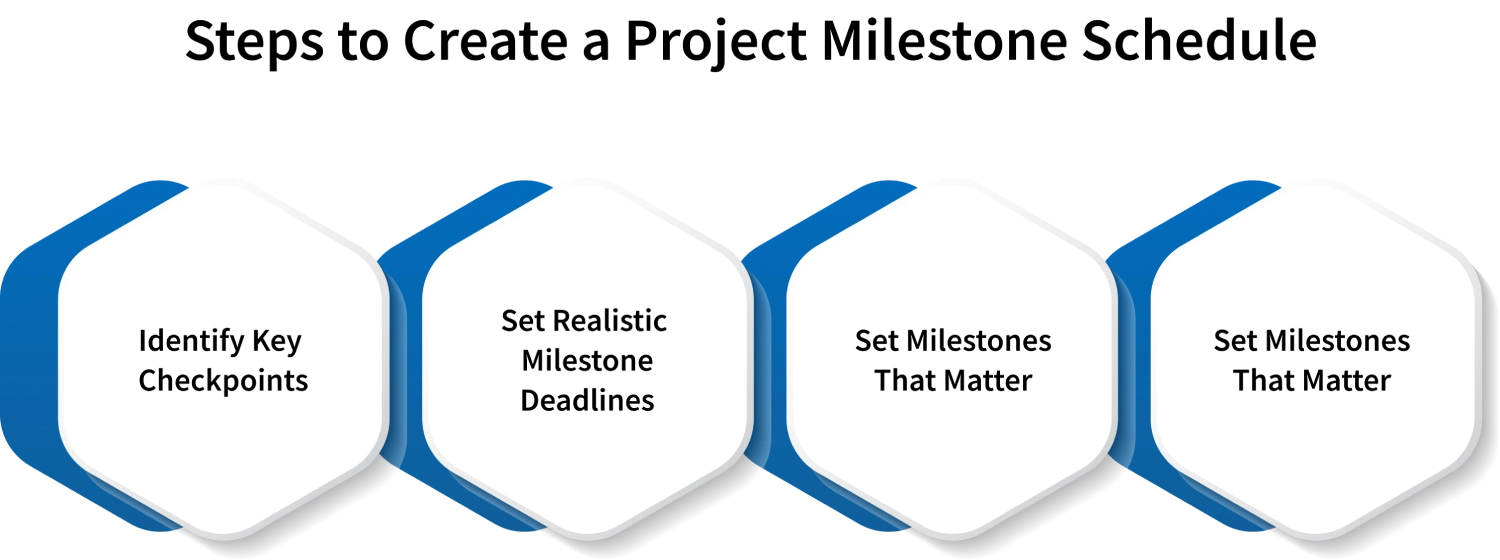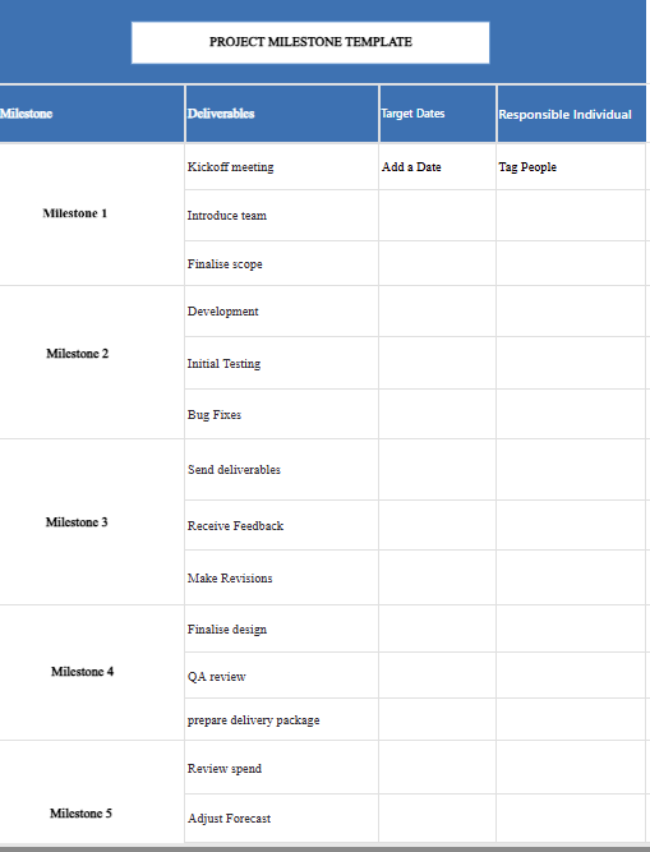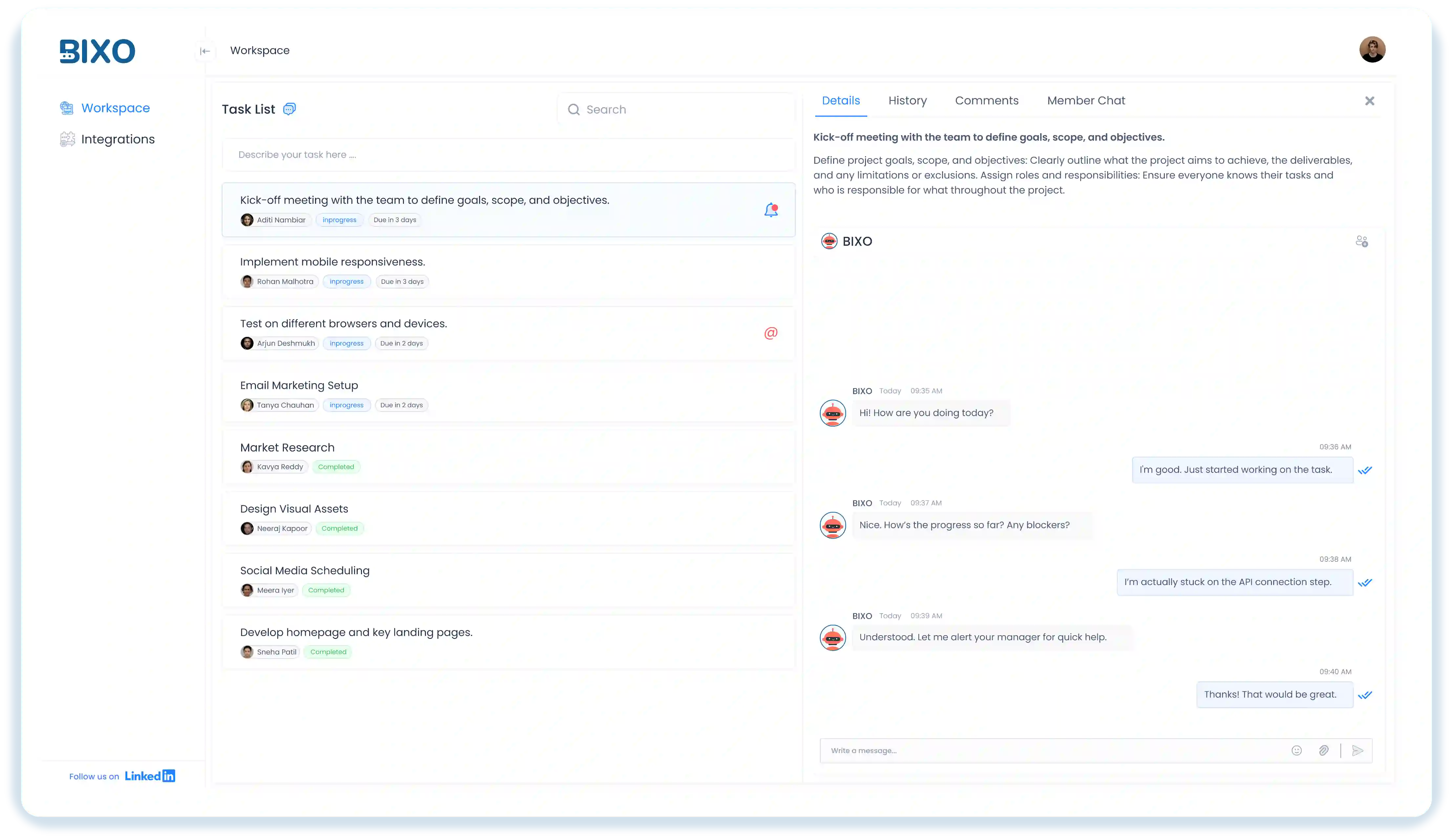
Table of Content
Focus on what matters. BIXO handles the rest!

Sometimes, managing a project can feel confusing, with too many deadlines, multiple tasks, and things to remember. But with the right project milestones in your planning, you will always know how far you have come and what the next step is in your project. These milestones are not just dates on a calendar. They are proof that your project progress is real. In this blog, you will understand what project milestones are, how they differ from tasks and deliverables, and how to use these milestones to manage your timeline more effectively. You will also receive some real-life milestone examples and a ready-to-use template to make your planning easier.
What Is a Project Milestone?
The project milestones are the key points that show the real progress in your project. It represents a major event or achievement like finishing a big task, getting approval, or reaching a deadline. Think of these milestones as checkpoints on a map. They help you to see how far you have come and what is remaining to complete. Instead of tracking every little task, milestones highlight the most important moments in your project journey.
These milestones do not involve actual work, but they show that you have completed something important. Whether it is launching a new feature, finishing a design phase, or completing a round of testing, each milestone tells you that your project is on track.
Why Project Milestones Are Important for Project Success?
Using project milestones gives you more control over your project journey. They help you to break the big task into smaller goals, so you can track progress and stay on schedule. When you set the right key milestones in your project, it becomes easier to manage your team.
Here is why milestones are important for your project success:
- Milestones give you clear checkpoints to measure progress.
- They help in keeping your team focused and motivated.
- Milestones make it easier for team communication about updates with stakeholders.
- Allows you to adjust plans early when delays happen.
- Boost confidence by celebrating small wins in your team.
- Keep your overall project timeline on track.
How to Create a Project Milestone Schedule?
Creating a clear milestone timeline can help you guide your team smoothly from start to finish. When you know what your goal is for the project and when you want to achieve the milestone, your project becomes much easier to manage. Instead of losing track of your project, you will have a clear plan that shows you what is coming next in your project.

Identify Key Checkpoints
Start by figuring out the most important checkpoints in your project. These are the moments where big progress happens, like finishing a major task, getting approval, delivering something important, or completing a task before a deadline. These moments are your key project milestones. Identify the main events that move your project forward, not every small task in your project.
Set Realistic Milestone Deadlines
Make sure your milestones have deadlines that your team can actually meet. Do not rush or set impossible dates that your team cannot achieve. Consider the resources, workload, and time needed for each phase of your project. Track deadlines helps your team to feel more confident and reduces stress during project management milestones.
Set Milestones That Matter
Not every moment in your project needs to be a milestone. Focus only on the events that are truly marked as important for progress, like key priorities for your team and the stakeholders. Milestones of a project should reflect real moments in your project, like completing a phase, launching a feature, or getting approval. If the task or goal does not move your project forward, it does not need to be a milestone.
What are the common Examples of Project Milestones?
Every project has important checkpoints that show you are making progress. These project milestones help you to stay organised, share updates with stakeholders, and feel confident about how things are moving forward. Here are some key examples you can use in your own project plans.
Project Start and End
Your project begins with a clear starting point and ends with a final task. The project start milestone shows your team when to start the project. The end milestone shows when the project is finished. These two points give a clear beginning and ending to your project.
Smarter Use of Resources
With critical chain project management , each person gets the right amount of time to finish their task without being overloaded. CCPM ensures that team members know exactly what to do and when to complete a task by removing confusion and keeping work on track Using CCPM tools and time wisely without any waste leads to better planning and smoother coordination between the team. You finish most of the work without stressing the team.
Deliverable Completion
Every time you finish an important task or product, it becomes a milestone. The milestone shows real progress in your project. This progress helps you and your team to stay on track and feel good about moving forward in your project. It also lets others know that you are reaching your goals step by step.
Phase Completion
Projects often go through different stages, like project planning , building, and testing. When one of these phases is completed, you reach or achieve a milestone. When you reach a milestone, it is a good time to pause, check your work, and prepare for what is next to reach another milestone.
Stakeholder Approvals
Sometimes, your project needs approval from clients, project managers, or other people. Their approval means your work meets their expectations. When they officially approve your plan, it becomes a key project milestone for your project. It gives you confidence and signals that you can safely move forward to the next stage without any delays.
Key Deliverables
In every project, some tasks are more important than others. Those important tasks are your key deliverables. Key deliverables are the tasks that your team needs to absolutely complete within the time. Reaching those project deliverables is a big achievement, so they have to be marked as milestones. Focusing on these keys helps you and your team to stay aligned with goals and reminds your team what really matters.
External Reviews or Audits
At a certain point, your project needs to be checked by people who are not in your team, like clients, quality experts, or auditors. These reviews are not just formal steps; they are also important project milestone examples. They help to ensure that the project meets the expectations and is ready for the next stage without any issues.
Budget Review Checkpoints
Keeping track of the budget is just as important as tracking the tasks. Budget review checkpoints help you check how much you have spent on your project. These checkpoints help you catch issues early, avoid overspending, and make smart financial decisions before it is too late.
What Are Common Challenges in Setting Project Milestones?
Setting project milestones sounds simple, but there are a few common challenges that can cause confusion or delay.
Here are some of the common challenges in setting the project milestones and how to avoid them.
Too Many or Too Few Milestones
If you add too many milestones, your project may feel too complicated. It can make progress harder to track and slow down the team. On the other hand, if you set too few milestones, you miss chances to check and celebrate progress. Find a balance between these two milestones. Focus only on the most important moments that show real progress.
Mixing Up Milestones and Tasks
A task is something you do, like designing a page or writing a report. A milestone is marked when something important is achieved, like finishing the design phase or getting client approval. If everything becomes a milestone, you will lose clarity on your project. Milestones should be checkpoints of your achievements. Not every small activity is a milestone.
Not Linking Milestones to Project Work
Sometimes people add milestones that do not match the real work. If your team cannot clearly see how a milestone connects to their tasks, it is not useful. Every milestone should reflect the real progress in the project work. When your team knows why a milestone matters, they will stay more focused and motivated.
Project Milestone Template to Plan and Track Progress
When you are planning a project, you may hear about the words critical chain and critical path. They may sound similar, but each method has its own differences. These methods change according to how you manage your work and resources.

Manage Your Project Milestones Effectively Using BIXO

Project milestones are like small checkpoints that guide your team from the start of a project to the finish. With BIXO, you can set, track, and update these milestones in a simple way. Each milestone works as a clear checkpoint that shows how far you have completed the work and what the next step of your project is. Milestones with BIXO are more than deadlines; these are real progress trackers. These milestones become clear goals that your team can see and celebrate. When milestones are linked to daily work, your team feels motivated, stays on track, and gets an energy boost every time a milestone is achieved. This makes your project move forward smoothly and with confidence.
Conclusion
Understanding and managing your project milestones is key to keeping your projects on track. When you set clear milestones, you create a step-by-step plan that guides your team toward success. By focusing on important checkpoints, deadlines, and approvals, you can measure progress and celebrate achievements. With BIXO, AI manager assistant managing milestones becomes even easier. It helps you track every stage, share updates automatically, and keep your team aligned toward common goals. Every milestone you achieve with BIXO brings you one step closer to completing your project successfully.
FAQs
There is no fixed number of milestones. Your milestones should highlight key moments that show real progress, not every small task in your project.
Yes, project milestones can change if there are any updates in your project’s scope or timeline. Adjusting these milestones helps to keep your plan realistic and stay on track. It is important to review and update them as needed during the project.
You can use tools like BIXO to create, track, and update your project milestones easily. BIXO offers an easy way to plan milestones, assign tasks, and keep your whole team connected in one place.
Yes, most projects benefit from having milestones because they help you to organise tasks and see how your project is progressing. Milestones make it easier to stay on track and reach your goals..
Get a demo of BIXO
Recommended Blogs

What Is an AI Project Management Assistant? A Complete Guide
Learn how an AI Project Management Assistant helps you organise tasks, automate updates, save time, and improve project results with less effort.
 vishnu-priya |
vishnu-priya |
 Oct 24, 2025
Oct 24, 2025


